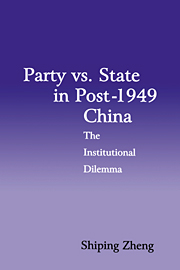Book contents
- Frontmatter
- Contents
- List of Tables
- Acknowledgments
- List of Abbreviations
- Part I Introduction
- 1 Understanding the State and Party in China
- 2 Where did the Chinese State Come From?
- Part II State-building under a Revolutionary Party: The Mao Zedong Era
- Part III State-building under a Reformist Party: The Deng Xiaoping Era
- Conclusions
- Appendix A CCP Membership Changes, 1921–96
- Appendix B Campaigns in China, 1950–89
- Bibliography
- Index
2 - Where did the Chinese State Come From?
Published online by Cambridge University Press: 23 September 2009
- Frontmatter
- Contents
- List of Tables
- Acknowledgments
- List of Abbreviations
- Part I Introduction
- 1 Understanding the State and Party in China
- 2 Where did the Chinese State Come From?
- Part II State-building under a Revolutionary Party: The Mao Zedong Era
- Part III State-building under a Reformist Party: The Deng Xiaoping Era
- Conclusions
- Appendix A CCP Membership Changes, 1921–96
- Appendix B Campaigns in China, 1950–89
- Bibliography
- Index
Summary
STATE institutions are not built overnight, nor does a state come from nowhere. Scholars of international relations often trace the beginning of the modern state to 1648 when the Peace of Westphalia began the end of the Holy Roman Empire. In England, the year 1648 witnessed the climax of the civil war between the king and Parliament, an event that signified the modern institution-building in England. In France, the 1789 Revolution represented a direct challenge by the Third Estate in the National Assembly to King Louis XVI's power and his great great-grandfather's claim, “L'état, c'est moi!” France since then has experienced several alternations between empires and republics, coupled with revolutions and wars. The American state-building has also gone through what Stephen Skowronek describes as “patchwork” during 1877–1900 and as “reconstitution” during 1900–20. All this suggests that state-building is a long and often bloody process.
China came late to this process of state-building. In the 1640s, the Manchu rulers of the Qing dynasty had just begun their reign of more than two centuries in China. By the late eighteenth century, the Qianlong emperor, while reaching the end of his reign, was still capable of waging wars against Vietnam and Nepal and of suppressing a series of rebellions at home. Since the mid-nineteenth century, however, China had entered a long period of political chaos, national disintegration, foreign invasion, and civil wars.
- Type
- Chapter
- Information
- Party vs. State in Post-1949 ChinaThe Institutional Dilemma, pp. 23 - 50Publisher: Cambridge University PressPrint publication year: 1997



